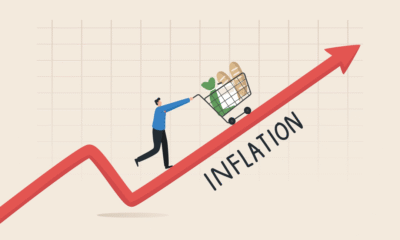Finance
Understanding the Decline of US Credit Scores in 2025

Understanding Credit Scores
Credit scores serve as numerical representations of an individual’s creditworthiness and are pivotal in the financial landscape. These scores typically range from 300 to 850, with higher figures indicating a lower risk to lenders. A strong credit score can significantly influence various aspects of financial life, including loan approval, interest rates, and insurance premiums. Consequently, understanding credit scores is essential for navigating the complexities of personal finance.
The calculation of credit scores is derived from several crucial factors. Primarily, payment history accounts for about 35% of a score, emphasizing the importance of timely bill payments in maintaining a positive financial reputation. Secondly, credit utilization, which reflects how much credit a person is using relative to their total available credit, constitutes roughly 30%. A lower utilization ratio signals greater financial responsibility. Additionally, the length of credit history makes up about 15%, with longer histories generally viewed more favorably. New credit inquiries and the variety of credit types managed also play a role, comprising 10% and 10% of the score respectively.
Numerous factors can influence credit scores, including changes in consumer behavior, economic conditions, and even shifts in financial regulations. These elements can cause fluctuations in individual scores, affecting one’s ability to secure favorable loans. As we look towards 2025, it is essential to recognize the evolving trends and emerging challenges that could potentially alter the landscape of credit scoring. This understanding will lay a foundation for discussion on the anticipated decline in credit scores and its broader implications in the near future.
Historical Trends in US Credit Scores
The history of credit scores in the United States reveals significant fluctuations influenced by various socio-economic factors. Since the introduction of credit scoring in the 1950s, the average credit score has witnessed both increases and declines, reflecting the overall economic landscape. The FICO score, one of the most commonly used credit scores, ranges from 300 to 850, with a score of 700 or above generally considered good. Over the decades, there has been a gradual upward trend in average credit scores, particularly during periods of economic stability and growth. However, this upward trajectory has been punctuated by pronounced declines correlating with economic downturns.
During the early 2000s, for example, the US experienced a housing boom, leading to higher credit scores as individuals leveraged low interest rates to purchase homes. Yet, when the financial crisis struck in 2008, a significant number of borrowers faced foreclosure, leading to a dramatic decrease in average credit scores. The economic uncertainty that followed resulted in increasing unemployment rates and a tightening of lending standards, making it difficult for consumers to maintain or improve their credit health.
Moreover, the socio-economic dynamics, including income inequality and changes in employment trends, have further contributed to these credit score variations. As more households faced financial distress due to rising costs of living and stagnant wages, their ability to make timely loan payments diminished, further suppressing average credit scores. Recent shifts towards digital lending and the gig economy reflect changing financial behaviors and highlight the evolving factors affecting credit health. Understanding these historical trends provides a vital context for analyzing the projected decline of US credit scores in 2025, as it underscores the ongoing relationship between economic circumstances and consumer credit management.
The Factors Contributing to Dropping Credit Scores in 2025
The landscape of consumer credit in 2025 is anticipated to be significantly influenced by several key factors that could contribute to the decline of credit scores across the United States. One of the foremost drivers is the rise in inflation, which has made everyday expenses increasingly burdensome for many households. As inflation continues to escalate, the cost of essentials such as food, housing, and transportation rises, straining the financial stability of consumers. This relentless squeeze on disposable income often leads to a cascade of financial difficulties, resulting in delayed or missed payments on credit obligations.
In addition to inflationary pressures, the increasing cost of living is playing a crucial role in the deterioration of credit scores. Many individuals are forced to allocate a larger portion of their income towards basic needs, leaving less room for discretionary spending and savings. Consequently, this heightened financial strain can result in difficulties in managing existing debt, fostering negative credit behaviors that further degrade credit scores.
Student debt accumulation is also a substantial contributor to the decline in credit scores. With the rising costs associated with higher education, graduates often find themselves burdened with significant debt load, which can impede their ability to make timely payments on other credit accounts. The challenge of juggling multiple financial responsibilities can easily lead to missed payments, adversely affecting creditworthiness.
Furthermore, other financial pressures, including unexpected medical expenses or job instability, may compound these issues. Consumers facing such hardships may resort to credit utilization to cope, which can negatively impact their credit scores when combined with a history of late payments. As these interconnected factors continue to unfold, they are likely to create a precarious environment for credit scores in 2025, impacting the financial health of countless individuals across the nation.
Impact of Economic Policies on Credit Scores
The relationship between economic policies and credit scores is intricate and multifaceted. In an evolving economic landscape, various fiscal and monetary strategies employed by the government can significantly influence consumer creditworthiness. Among these strategies, the manipulation of interest rates plays a crucial role. For instance, if the Federal Reserve opts to increase interest rates to combat inflation, borrowing costs will rise. This action may lead consumers to default on loans or credit card payments more frequently, consequently causing a decrease in credit scores across the board.
Lending regulations are another area where government policy can impact credit scores. Adjustments in regulations often dictate how lenders assess creditworthiness and extend credit. Stricter lending regulations, introduced in response to economic instability, might limit access to credit for consumers with previously higher credit scores. This limited access not only affects individuals seeking loans but can also exacerbate a decline in overall credit scores as fewer people are able to maintain optimal credit utilization ratios. As credit becomes harder to obtain, those with lower scores may find it increasingly difficult to improve their financial standing.
Moreover, various economic stimulus measures can have both direct and indirect effects on credit scores. For example, policies aimed at enhancing job growth may initially bolster consumer confidence, leading to improved payment behaviors and maintenance of better credit scores. However, if such policies fail, the subsequent job market instability can lead to economic decline, where a substantial number of individuals face challenges in meeting their financial obligations. This can ultimately result in a broad deterioration of credit scores across the population.
As we approach 2025, understanding the implications of these economic policies on credit scores is more crucial than ever. By monitoring the actions taken by policymakers, consumers can better navigate the financial landscape and protect their credit health in the face of evolving economic developments.
Technological Advances and Credit Scoring Models
The landscape of credit scoring models is undergoing significant transformation, largely due to advancements in technology. Traditional methods of assessing creditworthiness have primarily relied on historical data, such as payment history and debt levels. However, the introduction of sophisticated algorithms and artificial intelligence (AI) is shifting the paradigm toward more dynamic and nuanced evaluations. These new technologies enable lenders to analyze vast amounts of data, including non-traditional factors, which can lead to a more comprehensive understanding of an individual’s financial behavior.
For instance, predictive analytics allow businesses to foresee potential credit risks by evaluating patterns and trends in consumer behavior. This involves not only looking at credit history but also examining factors such as income flow, employment stability, and even social signals from online activities. As a result, individuals with limited traditional credit histories may find themselves receiving a credit score appealingly influenced by alternative data sources. While this expansion in criteria offers opportunities for some, it also introduces uncertainties in how scores can rapidly change based on the implementation of new technologies.
Additionally, the integration of machine learning algorithms is paving the way for credit scoring models that continuously learn and adapt. As these systems assimilate more data, they may produce more accurate assessments; however, they also raise concerns about the potential for bias and discrimination inherent in automated decision-making processes. The unpredictability associated with these models can lead to significant fluctuations in credit scores for consumers, sometimes for reasons that are not clearly articulated or understood. In the long term, as these technologies evolve, they hold the potential to fundamentally reshape the credit scoring landscape, leading to both opportunities and challenges for consumers and lenders alike.
The Consequences of Decreased Credit Scores
The declining trend in credit scores among consumers is a pivotal issue that can have wide-ranging implications on both individual finances and the overall economy. As credit scores decrease, individuals may find it increasingly challenging to secure loans, which could result in a significant ripple effect across various sectors. Lenders often use credit scores as a critical measure of creditworthiness; therefore, lower scores can lead to higher incidence of loan denials. This not only restricts access to necessary funding but also stifles personal ambitions and financial growth.
Furthermore, for those who do manage to secure loans despite a declining credit score, the terms often become less favorable. One immediate consequence of a lower credit score is the increase in interest rates associated with loans. Lenders typically view individuals with lower credit scores as higher risk, leading them to charge higher rates in compensation for that risk. This can lead borrowers into a cycle of debt, as higher payments on loans may impede their ability to manage other financial obligations effectively.
The implications of decreased credit scores transcend personal finances; they contribute to broader economic challenges. Lower consumer creditworthiness can lead to reduced consumer spending, as individuals become increasingly cautious about taking on debt. This decreased spending can stymie growth in various industries, including retail and housing markets, ultimately impacting job growth and economic stability. A cycle of diminished credit scores could lead to a significant contraction in consumer confidence, perpetuating a recession-like atmosphere.
In summary, the ramifications of falling credit scores are extensive and far-reaching, affecting individual loan approvals, interest rates, and broader economic health. As understanding of these consequences becomes more widespread, individuals and policymakers alike must prioritize strategies to mitigate the decline in credit scores to safeguard personal and financial well-being.
Managing Credit Health in a Declining Score Environment
As the landscape of credit scores shifts, individuals must proactively manage their credit health to mitigate the impact of a declining score environment. This requires a multifaceted approach that encompasses effective budgeting, improved financial habits, and vigilant monitoring of credit reports.
Firstly, budgeting plays a crucial role in maintaining financial stability. A well-structured budget enables individuals to track their income and expenses systematically, ensuring that essential payments, such as credit card bills and loan installments, are made on time. To enhance this process, it can be beneficial to utilize budgeting tools or apps that provide real-time insights into spending habits. By cutting down on unnecessary expenses, individuals can free up funds for debt repayment, thereby positively influencing their credit scores.
In conjunction with budgeting, developing better financial habits is essential. This includes making consistent payments above the minimum amount due on credit accounts. Paying down high-interest debt should take priority, as this can reduce the total debt load more effectively. Additionally, keeping credit card utilization below 30% of available credit limits is advisable. This strategy demonstrates responsible credit management and can prevent further deterioration of one’s credit profile.
Another key step is the regular monitoring of credit reports. Individuals should access their credit reports at least once a year, as this allows them to identify any discrepancies or unauthorized accounts that could negatively impact their scores. Utilizing free services that provide credit score alerts can also help individuals stay informed about changes in their credit health.
Lastly, for those experiencing significant difficulties, seeking financial assistance can be a prudent choice. Consulting with a credit counselor can provide tailored advice and resources for debt management. These professionals can assist in developing a personalized plan for credit recovery, providing the support necessary to navigate a declining score environment effectively.
Consumer Awareness and Education
As the landscape of credit scores continues to evolve, consumer awareness and education have become paramount in navigating the complexities of personal finance. Financial literacy plays a crucial role in understanding one’s credit score and its implications on overall financial health. Educational initiatives focusing on credit management aim to empower individuals with the knowledge necessary to make informed decisions about their credit. This empowerment is essential in a climate where many consumers may feel overwhelmed by credit-related information and the factors influencing their scores.
Various resources are now available to individuals seeking to improve their understanding of credit scores. Many non-profit organizations and financial institutions have developed programs that offer workshops, webinars, and online courses specifically designed to enhance financial literacy. These educational tools often cover critical topics, such as the components of a credit score, the importance of timely payments, credit utilization ratios, and strategies for credit repair. By utilizing these resources, consumers can gain insight into how day-to-day financial choices impact their credit standings.
Moreover, recent technological advancements have made it easier for individuals to access tools that facilitate the monitoring of their credit health. Numerous apps and websites allow users to check their credit scores regularly, track changes over time, and receive customized advice based on their specific financial situations. Such tools encourage proactive engagement, prompting consumers to develop better habits related to debt management and spending. Through continuous education and awareness, individuals can take control of their credit scores, which, in turn, helps in combating the decline witnessed in credit scores nationwide as projected for 2025.
Conclusion and Future Outlook
The examination of the decline of US credit scores in 2025 reveals several critical factors that have contributed to this trend. Economic instability, increased debt levels, and changing lending practices have all played a role in diminishing credit scores across various demographics. As we have discussed, the implications of these changes are far-reaching, affecting not only individual financial health but also broader economic conditions.
However, while the current situation may seem daunting, there remains a glimmer of hope for recovery. Various economic forecasts suggest that the financial landscape is cyclical and adaptable, indicating potential improvement in credit conditions in the years following 2025. With a strategic approach, consumers can take proactive steps to bolster their credit scores. This includes prioritizing timely debt repayment, minimizing credit utilization, and regularly reviewing credit reports for inaccuracies—all of which are effective strategies for credit score enhancement.
Moreover, financial education plays a pivotal role in the recovery process. As consumers become more aware of the factors influencing their credit scores, they can make informed decisions that promote better financial behavior. Institutions and policymakers can further support this recovery by offering resources that empower individuals to rebuild their credit effectively. Awareness campaigns and financial literacy programs could significantly help in equipping consumers with the necessary tools to navigate a challenging credit landscape.
In conclusion, while the decline of US credit scores in 2025 presents a challenge, it also serves as a catalyst for consumers to become more financially literate and proactive in managing their economic well-being. Through concerted effort and strategic planning, there is potential for recovery and improvement in credit scores, fostering resilience in the face of adversity.
Investing
Global Investor Outflows from U.S. Stocks & Dollar

In a shift that is sending ripples across financial markets, institutional investors around the world are pulling back from U.S. equities and reducing exposure to the U.S. dollar, signaling a significant change in sentiment toward American assets. According to the latest Bank of America Global Fund Manager Survey, global investors are now the most underweight on U.S. stocks in more than two decades, with the dollar facing similar skepticism as a long-term safe-haven asset. This transition is being fueled by multiple converging factors, including geopolitical instability, growing U.S. fiscal deficits, trade tensions, and an increasingly favorable investment climate in Europe and select emerging markets. For investors, economists, and policymakers alike, this trend represents a rebalancing of global capital flows that could reshape market dynamics in the months ahead.
Investor Sentiment Toward U.S. Markets Hits Multi-Year Lows
The Bank of America survey, considered a key barometer of global institutional sentiment, reveals that fund managers have turned heavily underweight on U.S. stocks and the dollar, preferring instead to rotate their portfolios into European and Asian equities. The survey showed that 36% of participants are now net underweight U.S. equities—the highest level since 2003. At the same time, positioning on the dollar turned net negative for the first time in over five years, with investors citing mounting fiscal concerns, valuation extremes, and weakening macroeconomic indicators.
The U.S. equity market, especially the tech-heavy NASDAQ, has experienced an extraordinary bull run over the last several years. But now, investors are questioning the sustainability of elevated valuations, particularly as economic growth slows, earnings forecasts are revised downward, and inflation remains persistently above target. Many portfolio managers believe the best returns may no longer be found in U.S. assets alone.
Rising U.S. Debt and Fiscal Deficits Raise Red Flags
A key driver of investor caution is the ballooning U.S. fiscal deficit. The Congressional Budget Office (CBO) projects that the U.S. federal deficit will reach over $1.8 trillion this year, driven by increased government spending, rising interest costs, and lower-than-expected tax revenues. The national debt is now projected to exceed 125% of GDP by 2030, raising serious questions about long-term fiscal sustainability.
Investors fear that soaring U.S. debt levels could lead to a loss of confidence in Treasury securities, pushing yields higher and triggering volatility in global credit markets. This concern is magnified by the growing political polarization in Washington, which has led to repeated debt ceiling standoffs and policy gridlock. As a result, some asset managers are choosing to diversify their bond portfolios with sovereign debt from countries like Germany, Canada, and Australia—nations viewed as having stronger fiscal discipline.
Geopolitical Tensions Erode Dollar Safe-Haven Appeal
The traditional role of the U.S. dollar as a global safe-haven currency is also being called into question. With the U.S. now embroiled in rising geopolitical conflicts, including its military engagement in the Middle East and an escalating trade war with China, the perception of the dollar as a “neutral” or stable currency is beginning to fade. Several countries, particularly in the Global South, have voiced frustration over the dominance of the dollar in international trade, and some have even accelerated efforts to settle trade in alternative currencies such as the euro, yuan, or local currency blocs.
In response, central banks in emerging markets are reducing their U.S. dollar reserves and increasing holdings in gold and non-dollar currencies. This trend, while gradual, is gaining momentum and contributing to the dollar’s underperformance against a basket of global currencies. The U.S. dollar index (DXY) has declined by nearly 6% year-to-date, reflecting both diminished investor confidence and a broader reconfiguration of reserve management strategies.
Attractive Valuations Abroad Drive Capital Outflows
While risks in the U.S. are mounting, attractive investment opportunities abroad are also contributing to the outflow of capital from American markets. European equities, particularly in sectors like green energy, luxury goods, and financial services, are seeing renewed interest thanks to relatively low valuations and improving macroeconomic stability. The recent ECB rate cuts and Eurobond discussions have added to optimism about the region’s fiscal and financial integration.
In Asia, countries like India, Indonesia, and Vietnam are emerging as new hotspots for foreign direct investment and equity inflows. These economies offer robust growth prospects, younger demographics, and increasingly tech-driven industries. Additionally, Japan’s bond market is seeing increased institutional buying, as long-term yields rise in response to the Bank of Japan’s policy changes.
This global diversification strategy is not just about seeking higher returns—it’s also about managing risk. Investors are increasingly looking to balance their portfolios geographically, reducing dependence on any single region and hedging against macroeconomic shocks that may be specific to the U.S.
Currency Hedging and Diversification as Defensive Strategies
In response to the dollar’s volatility, many fund managers are now engaging in currency hedging strategies to protect their portfolios. Currency ETFs, options, and forward contracts are being used to minimize the downside risk of a weakening dollar. At the same time, global investment funds are ramping up their exposure to non-dollar-denominated assets, including eurozone corporate bonds, emerging market debt, and local-currency sovereign issues.
Moreover, ESG and green bond markets in Europe and Asia are attracting capital due to their alignment with global sustainability goals. These instruments not only offer diversification but also align with broader institutional mandates on responsible investing.
Implications for U.S. Markets and Monetary Policy
The capital flight from U.S. assets could have significant implications for American markets. A persistent decline in foreign demand for U.S. Treasuries may force the Federal Reserve to intervene more frequently in the bond market to maintain liquidity and control yields. At the same time, a weaker dollar could contribute to imported inflation, complicating the Fed’s efforts to bring core inflation back within its target range.
On the equities side, if investor outflows persist, U.S. companies may face higher capital costs and declining valuations, particularly in sectors that rely heavily on foreign investment or exports. Domestic pension funds and institutional investors may need to fill the gap left by global investors, which could further alter asset allocation strategies and influence corporate financing decisions.
A New Era of Global Capital Rotation
The growing shift away from U.S. stocks and the dollar signals the beginning of a new era in global investing, one defined by diversification, geopolitical hedging, and currency rebalancing. While the U.S. remains a central player in global finance, the days of unquestioned dominance are beginning to fade, as investors embrace a more nuanced and distributed view of risk and opportunity.
For market participants, staying agile in this environment means tracking global fund flows, monitoring geopolitical developments, and reassessing the traditional U.S.-centric portfolio model. As capital continues to flow into European and Asian markets, the future of global finance is being rewritten—and those who adapt early may find themselves ahead of the curve.
Finance and Economy
France Pushes Eurozone Toward Joint Eurobond Issuance

In a bold move that could redefine the financial architecture of the European Union, France has renewed its push for the issuance of joint eurozone debt instruments – commonly referred to as Eurobonds – as a way to strengthen the euro on the global stage. As the EU prepares for its upcoming summit on June 26-27, the proposal is once again stirring heated debate among member nations. French officials argue that a shared debt mechanism is essential not only for financial resilience but also for elevating the euro’s standing as a credible alternative to the U.S. dollar. While the idea garners support from key institutions like the IMF and the ECB, resistance from fiscally conservative member states continues to block consensus. This article explores the implications of France’s proposal, the potential benefits and challenges of Eurobond issuance, and the evolving role of the euro in a multipolar financial world.
France’s Strategic Case for Eurobonds
French President Emmanuel Macron and Finance Minister Bruno Le Maire have long been advocates for deeper EU financial integration. According to them, Eurobonds would represent a tangible step toward fiscal solidarity and monetary cohesion, allowing member nations to borrow at collectively favorable rates while demonstrating political unity. The latest push comes at a time when the European economy is facing several headwinds: slowing growth, fragmented recovery across member states, and heightened global financial volatility triggered by geopolitical conflicts and energy insecurity. Macron has reiterated that a common debt tool is essential for financing major EU-wide projects such as green energy transition, digital infrastructure, and military defense.
From a strategic standpoint, France views Eurobonds as more than just a financial mechanism – they are a symbol of EU credibility and resilience. By pooling risk and aligning borrowing capacity, the eurozone could present a united front in capital markets, reducing the vulnerability of weaker economies and improving the euro’s attractiveness to foreign investors.
The Euro’s Current Global Standing and Its Challenges
Despite being the world’s second most-used currency, the euro still lags far behind the U.S. dollar in terms of global reserve share, trade settlement, and safe-haven preference. Analysts point out that one of the primary reasons for this is the fragmented nature of the eurozone bond market. Each country issues its own sovereign debt, leading to a lack of a single, risk-free eurozone bond benchmark – unlike U.S. Treasuries, which offer deep liquidity and low risk.
France’s proposal seeks to address this imbalance. A unified Eurobond market could create a highly liquid, stable, and scalable financial product that would attract central banks, pension funds, and sovereign wealth investors. Over time, this could shift more global reserves into euros, boosting the currency’s influence in global trade and finance.
Institutional Support: IMF, ECB, and Market Participants
Key international organizations have thrown their weight behind the idea. The International Monetary Fund (IMF) has suggested that Eurobonds could enhance the EU’s fiscal capacity and crisis response agility. Meanwhile, European Central Bank (ECB) officials, including President Christine Lagarde, have hinted that deeper fiscal integration is necessary for the euro to realize its full potential.
Financial market participants have also shown interest. Asset managers argue that Eurobonds could become a cornerstone of fixed-income portfolios, particularly for investors looking to diversify away from dollar-denominated assets. Some analysts compare the opportunity to the creation of the U.S. Treasury market in the post-war era, which laid the groundwork for the dollar’s global dominance.
Opposition from the Frugal Four and Risk-Sharing Concerns
Despite France’s enthusiasm and institutional support, significant opposition persists from fiscally conservative EU nations, notably Germany, Austria, the Netherlands, and Finland—often dubbed the “Frugal Four.” These countries argue that shared debt would penalize responsible fiscal behavior and open the door to moral hazard, where weaker economies might overborrow under the protection of joint guarantees.
German officials have also cited constitutional constraints and public opposition to any perceived “debt mutualization.” Instead, they advocate for reforms at the national level, more stringent budget controls, and the use of existing mechanisms like the European Stability Mechanism (ESM) for crisis funding.
This divide continues to stall formal negotiations. At the heart of the debate is the question of trust and fiscal governance, as many northern states remain skeptical about the long-term commitment of their southern counterparts to austerity and budget discipline.
Implications for Financial Markets and Investors
If approved, Eurobonds would be a game-changer for European capital markets. They would offer a new safe asset class, potentially rivaling U.S. Treasuries in size and reliability over the long term. For the European banking system, Eurobonds could provide high-quality collateral and improve liquidity conditions, especially for cross-border lending.
Investors are closely monitoring the situation. If the EU takes concrete steps toward joint bond issuance, bond yields across peripheral economies like Italy, Spain, and Greece could compress further, as risk premia shrink in anticipation of shared guarantees. Simultaneously, euro-denominated assets may see a surge in foreign inflows, especially from central banks seeking to rebalance reserve portfolios.
Strengthening the Euro’s Role in a Multipolar World
The geopolitical landscape is increasingly defined by multipolarity, with China, Russia, and the U.S. competing for influence in trade, finance, and security. In this context, the eurozone faces a historic opportunity to carve out a more assertive role. Strengthening the euro through fiscal and capital market integration is seen as essential to counterbalance the dollar’s dominance and reduce reliance on U.S.-led financial infrastructure.
Eurobonds could serve as a financial pillar in this transition. As global investors seek alternatives in a fragmented world economy, the euro’s rise as a stable, investable, and liquid currency backed by joint instruments could bolster its credibility and utility.
A Defining Moment for European Unity
France’s push for Eurobonds is more than just a fiscal proposal – it is a call for political and financial unity in a time of global uncertainty. While the road to consensus is steep, the growing support from institutions, investors, and southern EU members suggests that momentum is building. The upcoming EU summit will be a crucial test of the bloc’s ability to move beyond national interests and toward a shared financial future.
If successful, Eurobond issuance could redefine the eurozone’s role in the global economy, offering new tools for crisis response, economic development, and financial competitiveness. For investors and policymakers alike, this moment marks a critical juncture – either Europe seizes the opportunity to lead, or it risks remaining a secondary player in a rapidly evolving financial world.
Finance and Economy
Oil Price Spike as Middle East Conflict Deepens: A Global Market Wake-Up Call

The financial world is once again on high alert as escalating tensions in the Middle East have triggered a sharp surge in global oil prices, sending shockwaves through equity, commodity, and currency markets alike. With the U.S. reportedly striking Iran’s nuclear sites, Brent crude surged over 18%, nearing $80 per barrel in a matter of hours. The sudden volatility reignited fears of a potential $100 oil scenario, reminiscent of past geopolitical flashpoints that deeply impacted global supply chains, inflation expectations, and central bank policy stances. This article delves into the causes, consequences, and global financial implications of this emerging crisis.
The Trigger: U.S. Strikes on Iran’s Nuclear Infrastructure
On June 21, 2025, international news outlets confirmed that U.S. military forces had targeted Iranian nuclear facilities in what they described as a “pre-emptive defensive measure.” While the full extent of the damage is still being assessed, the attack has clearly escalated tensions in an already volatile region. The Middle East, being a vital hub for global oil production and shipping, plays a significant role in maintaining supply stability. Iran, which controls access to the Strait of Hormuz – a key chokepoint through which nearly 20% of the world’s oil supply passes—responded with threats to close the strait and intensify its military posturing. This heightened the risk premium in energy markets virtually overnight.
Oil Prices React Swiftly to Geopolitical Instability
Crude oil, especially Brent and West Texas Intermediate (WTI), reacted with extreme sensitivity to the developments. Brent crude jumped over 18% within a 24-hour period, while WTI saw a comparable surge. Analysts at Goldman Sachs and JPMorgan warned that if the Strait of Hormuz were to be blocked, prices could surpass $100 per barrel within weeks. The last time the oil market saw such an intense geopolitical premium was during the 2019 drone attacks on Saudi oil facilities. However, the current situation has a more severe undertone due to the involvement of nuclear assets and direct military strikes between two powerful adversaries.
Safe Haven Assets Soar as Risk Appetite Declines
As is common in times of geopolitical crisis, investors flocked to safe-haven assets such as gold, the U.S. dollar, and U.S. Treasuries. Gold climbed above $2,400 per ounce, a level not seen in years, while the U.S. dollar index rose nearly 2% as capital fled emerging markets and riskier assets. Meanwhile, 10-year U.S. Treasury yields fell sharply, reflecting a surge in demand for perceived low-risk instruments. Cryptocurrency markets, particularly Bitcoin, experienced a brief rally as some investors viewed digital assets as alternative stores of value, although that rally quickly reversed amid broader market instability.
Stock Markets Face Broad Sell-Off, Led by Energy-Sensitive Sectors
Equity markets around the globe responded negatively. The S&P 500 and NASDAQ both dropped over 2.5% in intraday trading, led by declines in consumer discretionary, industrials, and airline stocks, which are highly sensitive to fuel price increases. European indices such as the FTSE 100 and DAX also saw steep losses, while Asia-Pacific markets like the Nikkei 225 and Hang Seng Index fell sharply as investors priced in a higher global risk premium. Interestingly, energy stocks provided the only bright spot in an otherwise red sea of market activity, with companies like ExxonMobil and Chevron posting strong gains on expectations of rising revenues.
Inflationary Pressures Could Derail Central Bank Strategies
The surge in oil prices couldn’t have come at a worse time for global central banks. After years of battling inflation through aggressive interest rate hikes, many central banks had only just begun to pause or consider rate cuts in 2025. However, higher energy prices feed directly into inflation, particularly in transport, manufacturing, and agriculture sectors, potentially forcing monetary authorities to reverse their dovish pivot. The European Central Bank (ECB), which had recently initiated its first rate cut in years, may now face pressure to hold off on further easing. Similarly, the Federal Reserve, which had opted to maintain its current rate in the last FOMC meeting, is likely to adopt a more hawkish tone moving forward.
Emerging Markets Bear the Brunt of the Crisis
The fallout from spiking oil prices is especially damaging for emerging markets, which are typically more sensitive to commodity price fluctuations. Countries like India, Turkey, and South Africa, which are major oil importers and have significant current account deficits, saw their currencies depreciate against the dollar. This adds to inflationary pressures and increases the cost of dollar-denominated debt, complicating fiscal and monetary policy responses. Foreign institutional investors also withdrew capital from these markets, adding to equity market stress and further depressing sentiment.
Global Economic Growth at Risk
Economists are revising down global GDP forecasts amid fears that higher oil prices will dampen consumer spending, elevate production costs, and destabilize corporate earnings. According to the IMF, a sustained oil price above $90 could reduce global GDP growth by 0.5% annually, with some regions like Southeast Asia and Sub-Saharan Africa experiencing even greater negative impacts. Supply chains, already recovering from post-pandemic disruptions and trade tensions, now face renewed uncertainty due to potential shipping bottlenecks in the Persian Gulf.
Outlook: What Comes Next for Markets and Policymakers?
Going forward, much depends on how the situation in the Middle East evolves. A de-escalation through diplomatic channels, possibly via UN or EU mediation, could stabilize oil prices and soothe market nerves. On the other hand, if Iran follows through on its threat to block the Strait of Hormuz or retaliates militarily, the crisis could escalate into a full-blown regional conflict with severe repercussions for global trade and energy supply. Policymakers worldwide are monitoring the situation closely, and emergency meetings by OPEC and G20 finance ministers are already being planned. The International Energy Agency (IEA) has also signaled its willingness to release strategic petroleum reserves if needed to calm markets.
The Road Ahead is Uncertain but Manageable
In the face of rising geopolitical tensions and economic uncertainty, investors are advised to adopt a cautious, diversified approach. While markets remain volatile and unpredictable, sound investment principles – such as maintaining a balanced portfolio, avoiding over-leveraged positions, and focusing on long-term fundamentals – remain more relevant than ever. The oil price spike triggered by the U.S.-Iran conflict is a potent reminder of how global politics and finance are deeply intertwined, and why staying informed and agile is critical in today’s interconnected world.
-

 Finance & Investment6 months ago
Finance & Investment6 months agoEmerging Markets to Watch in 2025: Opportunities and Risks
-

 Technology and Finance8 months ago
Technology and Finance8 months agoThe Future of Quantum Computing in Financial Modeling and Trading
-

 Finance7 months ago
Finance7 months agoUSA Market Trends & Global Finance Insights
-
Finance7 months ago
Navigating Retirement in the Gig Economy: Challenges and Solutions
-

 Finance8 months ago
Finance8 months agoNavigating Personal Finance in the Age of Inflation and High Interest Rates
-

 Economics6 months ago
Economics6 months agoGlobal Markets React to U.S. GDP Contraction: A Comprehensive Analysis
-

 Investing & Finance8 months ago
Investing & Finance8 months agoFractional Investing: The Path to Wealth Democratization
-

 Finance7 months ago
Finance7 months agoTop 10 High-Yield Savings Accounts in the US (2025 Edition)




